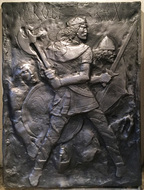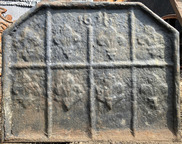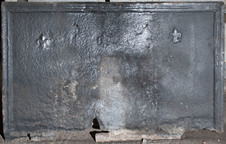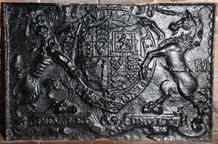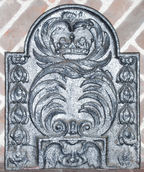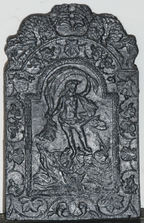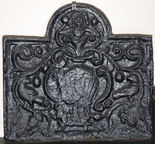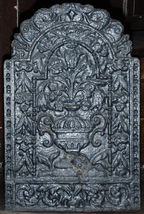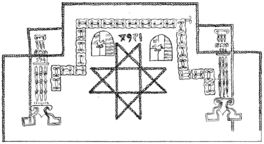-
1065
Description: Rectangular; no edging; rough background with 'incised' inscription across top in archaic lettering; central crowned male figure, in Saxon costume, standing astride and facing right, holding a battleaxe to his right in both hands; behind him to the right, a figure wearing a Norman-style helmet with nasal guard, advancing, with a shield, and a sword in his right hand; behind the central figure and to his right, a fallen figure with a circular shield covering him; below, the face of another fallen figure, also wearing a Norman helmet.
Notes: A dramatic pictorial fireback commemorating the Battle of Hastings. The pattern may have been made of a sculpted medium, such as clay.
Inscription: HAROLD REX
- Decoration tags:
- rectangular (shape)
- none (edging)
- whole carved pattern
- pictorial
- text
- humans
- objects
Manufactured: in the 20th century in England.
Current location: Mark Ripley Forge & Fireplaces, Northbridge Street, Robertsbridge, Salehurst, East Sussex, England.
- Attached to series:
- Commemorative firebacks
-
1166
Description: Rectangular shape; wide fillet and ogee-moulded edging; approximately top centre, initials RH, with date 1701 centred below.
Notes: A heavy casting, approx. 3cm thick; the character set for the initials and date lacks uniformity, some carved crudely, others more carefully; three horizontal planklines. The lettering differs from another fireback (see no. 1282), with the same initials and date, by the position and shape of the letter 'R'. Formerly in a house at Netherfield, East Sussex. The former location in the Netherfield area of these two firebacks suggests a possible association with Richard Hay, owner of land in that area at that time and ironmaster at Beech Furnace nearby.
Inscription: RH / 1701
- Decoration tags:
- rectangular (shape)
- fillet and ogee (edging)
- carved stamps
- individual letters
- individual numbers
- planklines
- text
Manufactured: in 1701 possibly at Beech Furnace, Battle in the Weald area of England.
Current location: Ripley Forge & Fireplaces, Northbridge Street, Salehurst, East Sussex, England.
- Attached to series:
- Date & initials firebacks
-
1265
Description: Canted rectangular shape; ?fillet edging; eight fleurs-de-lys (4 and 4) equally spaced and divided by vertical and horizontal fillets, the middle vertical over-stamped at the top with the numerals.
Notes: Only poor quality castings have been noted of this design, with different dates.
Inscription: 16[?]1
- Decoration tags:
- rectangular with canted top corners (shape)
- fillet (edging)
- whole carved pattern
- individual numbers
- heraldic
- text
Manufactured: in the early-17th century possibly in the Weald area of England.
Current location: Ripley Forge and Fireplaces, North Street, Robertsbridge, Salehurst, East Sussex, England.
- Attached to series:
- Miscellaneous stamp firebacks
-
1283
Description: Rectangular shape; ogee-moulded edging; upper centred, small fleur-de-lys stamp impressed three times, the rightmost slightly higher than the other two.
Notes: A simple fireback of somewhat indeterminate date.
- Decoration tags:
- rectangular (shape)
- cyma reversa/ogee (edging)
- carved stamps
- heraldic
- objects
Manufactured: in the 17th century possibly in the Weald area of England.
Current location: Ripley Forge & Fireplaces, Northbridge Street, Robertsbridge, Salehurst, East Sussex, England.
- Attached to series:
- Miscellaneous stamp firebacks
-
644
Description: Formerly arched rectangular, arch now missing; cavetto-moulded edging, invected on the inner edge; English royal Stuart shield, garter, crown (mainly missing), supporters and motto; date split either side of crown; monogram to right of unicorn supporter.
Notes: The monogram probably identifies the pattern-maker, whose invected edging seems to be a distinctive style. From another fireback of the same design (no. 1018), complete with the arch, the height is approx 710mm.
Inscription: 1638 / HONI SOIT QUI MAL Y PENSE / RN / DIEV ET MON DROIT
Arms: English Stuart royal
- Decoration tags:
- rectangular (shape)
- invested cavetto (edging)
- whole carved pattern
- individual numbers
- monogram
- armorial
- royal
- text
Manufactured: in 1638 in England.
Current location: Six Poor Travellers House, High Street, Rochester, Kent, England.
Museum number: A4328 (part of the Rochester Guildhall Museum museum group)
- Attached to series:
- RN series
- Carolean royal armorial firebacks
- Stuart royal armorial firebacks
-
646
Description: Arched rectangular shape; fillet edging; bell-flower column repeated on each side; at bottom, central rectangular panel, fillet edged, enclosing outstretched wings; above, intertwined leaves in figure-of-eight, enclosing a crown at the top.
Notes: This fireback incorporates features of the ‘Dutch’ style but within an English form.
- Decoration tags:
- rectangular with round arch (shape)
- fillet (edging)
- whole carved pattern
- heraldic
- plants
Manufactured: in the mid- to late-17th century in England.
Current location: Eastgate House, High Street, Rochester, Kent, England.
Museum number: A3484 (part of the Rochester Guildhall Museum museum group)
- Attached to series:
- Miscellaneous pattern firebacks
-
647
Description: Arched rectangular central panel with hollow bead-on-fillet edging; pictorial scene of a female figure standing on a scallop shell on a ground, holding wind-blown drapery aloft; arched rectangular border with fillet edging; top centre, a scallop shell with descending tendrils and alternating flowers and scallop shells, and swirled leaves at the bottom; on top, mirrored serpents.
Notes: The allegorical figure of Fortune; similar in many respects to other ‘Dutch’ style firebacks of the period. The theft in 1699 from a Thames-side warehouse of several firebacks, including '5 iron Chimney-Backs cast in the figure of Fortune standing naked on a Conchus in the Sea' may refer to this type (Post Boy 11-14 Nov. 1699).
Copies of this fireback are known.
- Decoration tags:
- 'Dutch' (shape)
- fillet (edging)
- whole carved pattern
- pictorial
- allegorical
Manufactured: in the early-18th century in England.
Current location: Eastgate House, High Street, Rochester, Kent, England.
Museum number: A3490 (part of the Rochester Guildhall Museum museum group)
- Attached to series:
- British 'Dutch' style firebacks
-
653
Description: Arched rectangular shape; cavetto-moulded edging; central, two handled, fluted vase with swirled, fruited vines issuing from the neck, and a bird on each side perched within the vines; out of the neck, a naïve human figure with arms outstretched, grasping vines on each side.
Notes: The figure emerging from the vase has a symbolism which has yet to be explained.
Copies of this fireback are known.
- Decoration tags:
- rectangular with round arch (shape)
- cavetto (edging)
- whole carved pattern
- pictorial
- plants
- objects
Manufactured: in the mid- to late-17th century in the Weald area of England.
Current location: Eastgate House, High Street, Rochester, Kent, England.
Museum number: A3496 (part of the Rochester Guildhall Museum museum group)
- Attached to series:
- Gadrooned vase firebacks
-
654
Description: Arched rectangular central panel with bead-and-pellet edging; S-scroll, two-handled, gadrooned vase with tulip stems, flowers and leaves; arched rectangular border with fillet edging and suspended flower bunches; along a rectangular bottom panel with fillet edging a symmetrical arrangement of swirled foliage; on top, two symmetrical, coiled serpents; narrow, curved shouldered side panels with beads in oval depressions.
Notes: The presence of tulips suggest a Dutch origin for the pattern of this fireback, although the presence of several examples in England suggest that it was produced here rather than on the Continent.
Copies of this fireback are known.
- Decoration tags:
- 'Dutch' (shape)
- fillet (edging)
- whole carved pattern
- extension panels
- pictorial
- plants
- objects
Manufactured: in the mid-17th century in England.
Current location: Eastgate House, High Street, Rochester, Kent, England.
Museum number: A3507 (part of the Rochester Guildhall Museum museum group)
- Attached to series:
- Flower Vase 'Dutch' types
- British 'Dutch' style firebacks
-
1015
Description: Rectangular with two-stepped top; twisted rope edging (top and sides); twisted rope extensions enclosing intermediate step with rope continued parallel to sides; central rope octagram with reversed date above between repeated inverted shield shapes off-set (left higher than right); the shield blazon: barry wavy impaling quarterly, overlaid with a small bird stamp and an indistinct ?bird shape in the top left quarter as viewed; within the rope, a roughly parallel arrangement of 23 double-loop-patterned stamps, with the faint impression of an additional stamp in the top right corner of the arrangement; outside the loop stamps and partially overlying the vertical rope extensions, the impressions of two classically designed firedogs with Ionic capitals and fluted pilasters, bearing the date 1594, but with the '1' missing; the fluting on the pilasters has been overlaid by the repeated impression of a turned peg.
Notes: A large and remarkably elaborate fireback: the octagram, a device seen more commonly on French firebacks than on English ones, suggests an apotropaic purpose; the impression of the firedogs was clearly made after the laying of the rope lengths and impressed less deeply as the rope impression has not been obliterated by the firedog on the left side. A fireback with the same loop stamps bears the same date using the same numerals but impressed the correct way round. Currently obscured behind a wood stove.
Inscription: 4951 [5 reversed] / 594 594
- Decoration tags:
- stepped (shape)
- rope (edging)
- simple stamps
- carved stamps
- individual numbers
- apotropaic
- armorial
- text
- objects
Manufactured: in 1594 in the Weald area of England.
Current location: Fyning Manor, Rogate, West Sussex, England.
